From SimCity to Real Girlfriend: The Story of Simulation Games, Part 1
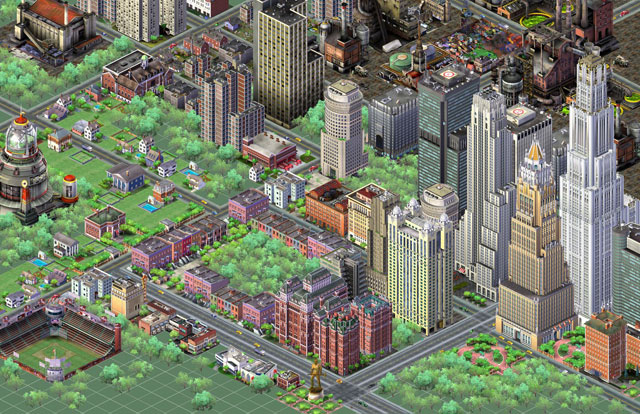
In the process of completing his first game, Raid on Bungeling Bay, Will Wright developed the level editor, which turned out to be more interesting than the game itself. Delving into the theory of urban planning and architecture, Wright transformed the editor into a separate product — more like a “software toy” than a video game that allowed players to build and manage a city. Users could divide territories into residential, commercial or industrial areas, build roads, power lines, build police stations and much more, hoping to create a viable, convenient city that could attract “sims” to live and work.
In essence, Wright created a simulation of the city: the player assumed the position of the all-powerful mayor who lived (and reigned) while the city was alive.
The game became the quintessence of the simulator: almost entirely with an open final, no clear goals, except for the player’s own set. Nevertheless, the creation of space architecture, observation of the dynamic reactions of the ups and downs of the city, attempts to fine-tune the balance to attract more residents turned out to be an incredibly interesting gameplay. The player could burn the city, enjoying the destruction (many people did), but in essence the creation of Wright stimulated the creation and creativity of the players.

SimCity
But the world was not ready for Micropolis and Wright was unable to find a publisher of an unusual game for Commodore 64. In 1987, three years later, Wright met at the now famous party with Jeff Brown's pizza, after which they together created Maxis. This was followed in 1989 by a joint publishing agreement with Brøderbund, and the game, renamed SimCity , was soon released for Amiga and Macintosh (other platforms followed in 1990).
After such a slow start, which corresponded to the general expectations of mediocre sales (only Brown didn't share them), word of mouth worked and the game turned into a huge hit. At a time when games were often considered part of the cultural underground, SimCity began to be discussed even in popular magazines such as Time magazine and The New York Times , and government organizations, private entrepreneurs, and educational institutions entered into agreements with the engine to license the engine or create special versions of the game.
The desire to feign reality, to establish a set of rules and systems that represent some aspect of life, seems to be common to all of us. Children play in the family, have tea parties with invisible tea, depict policemen, robbers, cosmonauts, researchers or doctors. Over time, these children grow up, become game developers and begin to create digital simulators of almost any action that can be imagined.
Of course, simulation games existed long before the advent of video games, but even if we restrict ourselves to video games, then we will have a huge variety of potential games. Therefore, before proceeding to the study of the long history of Sims Wright and other developers, let's define the rules: what can and can not be considered Sims.
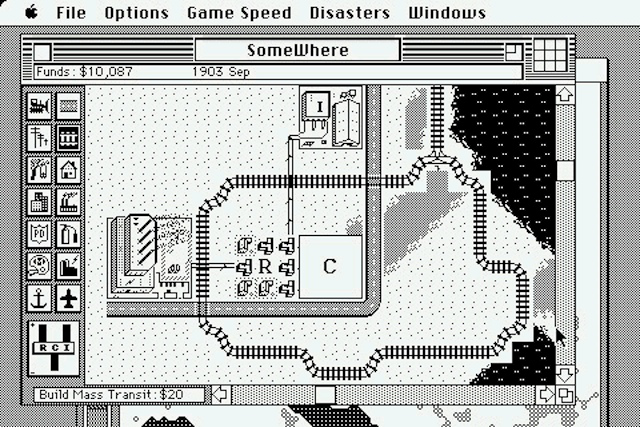
The Macintosh version of SimCity had high resolution graphics, but at first it was only black and white.
Existential issues
While doing research for this article, I came across two of the biggest obstacles. The first was the seemingly innocuous question: “What is a sim-game?” Some critics narrow down the requirements and believe that only transport simulators deserve this label, while others immediately recall the Sim franchise (of which probably the most popular are SimCity , SimAnt and The Sims ), developed primarily by Maxis and Will Wright.
Others have more extensive views and insist that any game that accurately simulates or simulates real-life systems should be considered a simulator, but this is quite a subjective approach because it requires a clear definition of the model “accuracy” and excludes simulators that take place in the future.
The second problem was the question of where to draw the line between pure “simulation” and “simulator game”, as well as between “simulator game” and “game with simulator elements”. Is Flight Simulator a game or something else? What about VBS1 ? Do I need to include in the category of sports games, racing games, God simulators and such hybrids of simulators as Balance of Power , Stronghold or Close Combat: First to Fight ? Can the future games be considered real Sims? What about games that simulate social interactions, but in a fictional entourage, as is the case with Animal Crossing ?
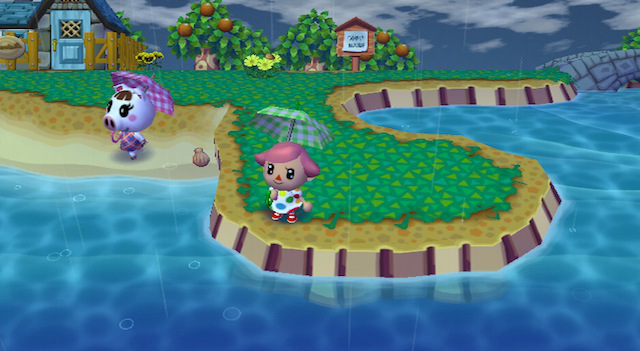
I can't bring myself to call games with anthropomorphic animals "life simulators" / Sorry if this upset you.
Reality, as always, is vague, and I decided to compromise, hoping to create a fairly close review of the evolution of the sim genre in one article. So here is my own list of criteria:
We completely ignore sports games, with the exception of racing simulators, which I will discuss in brief, because sports simulators are a subset of the sport genre rather than the simulator genre (and because they need to be studied in the appropriate context). For similar reasons, I also excluded tactical shooters, regardless of their realism, unless shooting is carried out exclusively from vehicles.
The malleable nature of sim games does not completely avoid genre hybrids, but I will focus on games where the main thing is not RPG elements, history or strategy, but simulation. In the case of simulators without transport, the less a player has direct control, the more likely the game will be mentioned in the article. In the case of transport simulators (including space and flight simulators), I am more inclined to “hardcore” simulators trying to simulate physics and control as realistically as possible, but still remaining video games, and not real training simulators.
In other words, in the article I will mainly consider the most important and / or innovative games, that is, many excellent sequels and spiritual followers will not be mentioned, especially if they have been released in the past few years. So let's get started.
Why stop at the city?
Based on the success of SimCity, Maxis quickly began to explore other aspects of the simulation. SimEarth (1990) by Will Wright may have surpassed Spore due to its enormous scope and focus on evolution. Playing the role of Gaia, first proposed by James Lovelock to a complex entity that connects all life on Earth, and having a feedback system that supports this life, the player must lead the development over the course of ten billion years of the Earth’s existence.
Although the game, after you figure it out, was certainly fascinating, SimEarth grabbed a piece that she couldn’t chew. Her clumsy graphics and active use of the menu only increased the confusion when the player tried to follow the development of animals, plants, pollution, epidemics, famine, continents, oceans, people and other aspects of life on Earth.
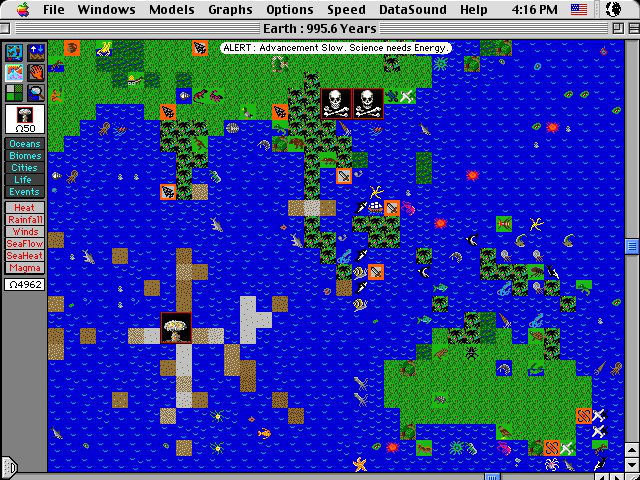
In the confusing but terrific SimEarth , children all over the world have played in the classroom.
Focusing more on Earth’s ecosystems, another Wright project, SimLife (1992), sought to simulate the genetics and interaction between species and the environment. However, she was (very) unsuccessful from the point of view of both the game and the scientific simulator, because she lacked clarity in the feedback from the player and the setting of goals, while she could not convey the subtle nuances of scientific research.
The most patient players viewed the game as an interactive playground in the spirit of Dr. Moreau's Island , but it simply annoyed everyone else. After the mixed successes and defeats of SimEarth , the inability of SimLife to make evolution and genetics fascinating to a wide audience showed that the inner workings of biological life was too complicated a topic even for sim games.
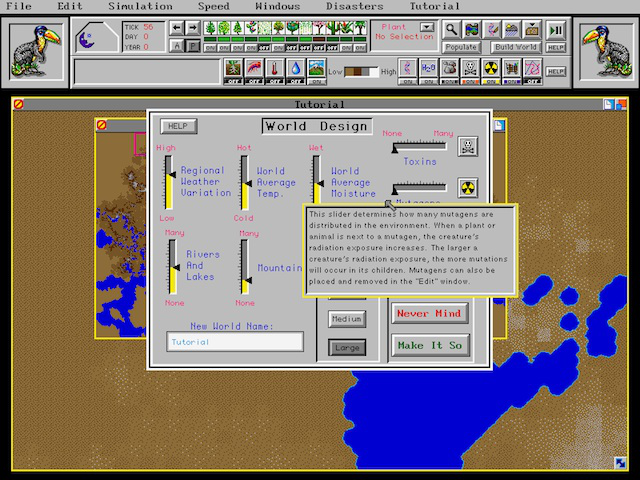
In the overly complex SimLife , there seemed to be a menu and detailed tips for anything.
The situation was different for a hybrid action / platformer / sim EVO: Search for Eden , a game of 1993 (in Japan - 1992) for Super Nintendo. She gave the player control over one form of life. The player could gradually evolve, collecting and spending evolution points, obtained by eating other forms of life - the choice of food influenced and influenced the development of the character.
Taking into account the rather strong simplifications that EVO made to the simulation of the evolutionary process and the display of the geological time scale, one may wonder whether it is worth mentioning at all in the article. But EVO was one of the few games that captured the very essence of the theory of evolution — adaptation and natural selection through inherited genetic traits. EVO was a rare game — only for consoles, but many of its ideas were recreated in the 2008 evolutionary hit Spore . For this, she deserves a mention as an interesting contribution to the evolution of "life simulators".

EVO: Search for Eden does not fully comply with the theory of evolution, but at least it seems like a good approximation to it.
Due to the huge scale, Spore expected that the game would become a “complete” Sim- game, a “simulator of everything”: the players started with prehistoric slime and went all the way to the evolution of galactic trade, with several unique and separate game modes. Unfortunately for hardcore fans, the scientific basis of Spore was simplified to meet the interests of a wide audience.
The result was a game that more modeled the ideas of creationism than of evolutionary theory, and which lacked everything except the last (cosmic) stages and the brilliant Creature Creator (which, eighteen days after the release of Spore, counted more than 1.8 million creatures created by players, and a year later passed for 100 million).
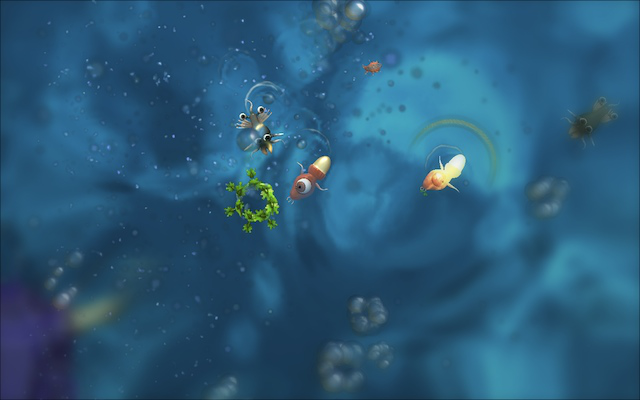
Spore disappointed many fans, because it greatly simplified the scientific approach that underlay its creation.
Glory to the ants!
SimAnt is one of Will Wright's strangest games, not only because it is dedicated to managing an ant colony, but also because it had a campaign mode in which the player’s goal is to drive people out of their home. It also has an experiment mode in which a player can build ant labyrinths, poison a colony, control a spider, or drive ants crazy with excessive doses of pheromone traces.
The real magic of SimAnt was how well it matched the admiration of many children by ants, especially their behavior in various difficult situations (for example, if you close the entrance to their nest or throw them a spider).
The player controlled the leader of a black colony, a rational creature, able to move into any body at will, to wage war against evil ant lions, spiders or a hostile red colony. One of the most exciting opportunities was the introduction of a red colony, that is, becoming a spy. With the right behavior, the player could force the red ants to feed themselves, even when he was nurturing plans to destroy their nests from the inside.

SimAnt on Mac
DO NOT REDUCE FINANCING
The release of SimCity 2000 in 1994 caused a big stir and expectations. The game came on the heels of an undervalued SimFarm , the “country relative” of the game SimCity . After the attempts of the new team to improve the original failed, Will Wright returned to the design leadership.
The top view was replaced with a 2D isometry with multiple viewing angles; in addition, a separate viewing mode was added to control the sewage system and subway paths. Meanwhile, the process of creating a city is one more step in evolution - some buildings became inaccessible for construction until the chronology of the game shows that the required technology has already been invented, therefore power stations disappeared from the game in the early stages of city life, airports appeared not earlier than 1900 technologies of the later stages of the game, for example, arcology, provided an explosive growth of the population and so overcrowded cities.
Probably the most interesting additions made to the feedback system. SimCity 2000 has added in-game newspapers to the franchise, whose articles talked about the problems, the tragedies and the triumphs of ordinary citizen-sims, served in a charming humorous manner. Also appeared a panel of advisers, with whom it was possible to consult on the budget. The most memorable of them flew into a rage at the slightest cuts in the transport budget, threatening the player with the words “CANNOT REDUCE FINANCING. YOU'LL PLEASE ABOUT THIS! ”

Funny newspapers have become one of the most striking features of SimCity 2000 .
Maxis problem escalation
The mid-to-late 90s were a difficult time for Maxis. The company sought to become a new EA, but it lacked the resources for it even after the huge success of SimCity 2000 . With the increase in Maxis staff, the management culture changed, and the main goals were the number of sales and the number of games released per year. As a result, games began to suffer from this. Games such as SimCopter , which allowed players to fly a helicopter through cities created in SimCity 2000 and SimIsle (an environmental theme version of SimCity ), were produced hastily, full of bugs and barely ready.
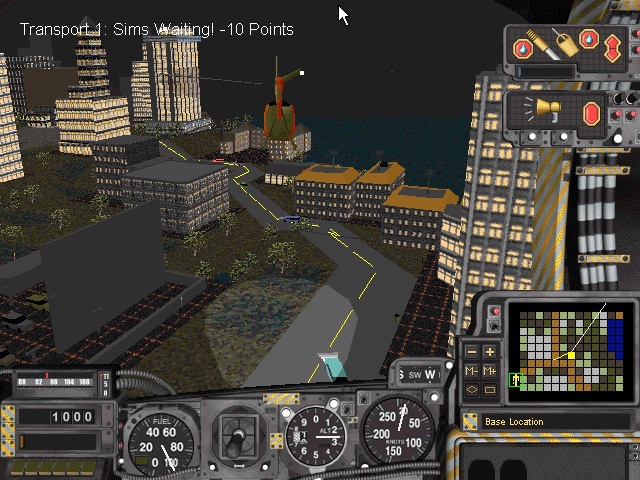
SimCopter game was supposed to be similar to the existence in the world created in SimCity . Unfortunately, she was more like torture.
At that time, the company released one impressive game, but it was developed in Japan and only published by Maxis. SimTower: The Vertical Empire (1994) Yuta Saito mixed the formula SimCity with aspects of business management of economic games. The user must be building a modern skyscraper and manage it. During the game, the player could track the moods and habits of residents, visitors and workers, which made it possible to optimize the location of elevators, shops, offices, apartments and other premises.
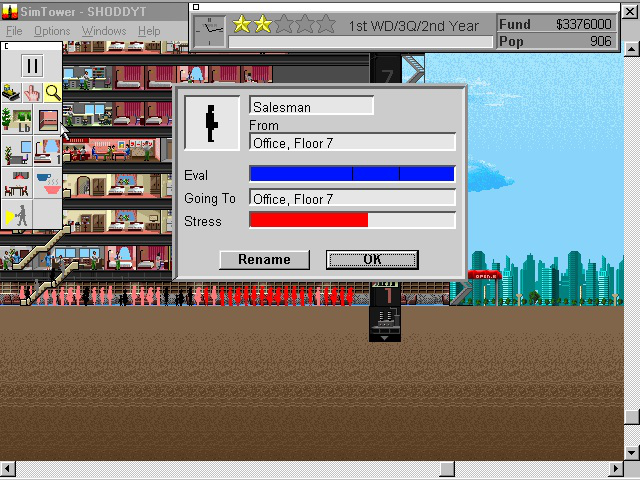
Incredibly fascinating SimTower , created by a man who later makes a strange game for the Dreamcast called Seaman .
Tropical paradise
SimCity was not the first video game to explore the idea of creating a community, but it was the first to be widely recognized, and Tropico (2001) was not the first simulator that took place on the island. Pioneer laurels should be given to Utopia , a 1981 game for Intellivision, released by Mattel Electronics and developed by Don Daglow.
Utopia borrowed the plot from a sixteenth century book by Thomas More with the same name, which captured the seemingly ideal, but fundamentally flawed island community, philosophically reasoning about human imperfection. The player ruled one island, while his opponent ruled others. He needed to build factories, farms, schools and other buildings so that people would be happy and develop. The game also simulated the main weather conditions, the movement of fish schools and pirates.
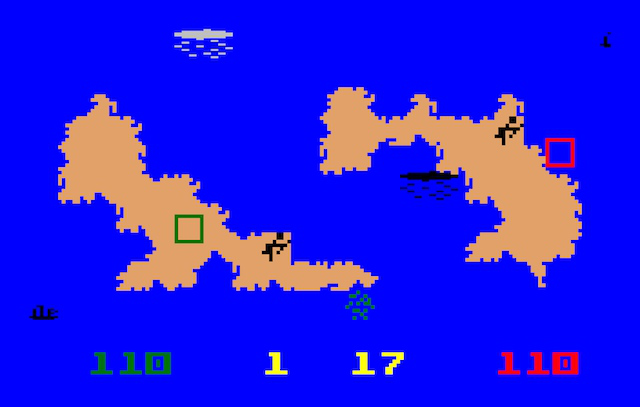
Utopia may not look impressive, but it has greatly influenced the video game industry.
If SimCity demanded to build a capitalist paradise, a city whose prosperity depended entirely on private entrepreneurship, Tropico simulated the development of a banana republic, which outwardly could look like capitalist or socialist, in which the player played the role of its leader stricken with corruption.
Having started in 1950, you have to lead your people on a Caribbean island to prosperity in fifty years. During the game, you have to pacify or destroy political factions, regulate relations with the United States and the Soviet Union, feed your people and profit from the export of raw materials. If you do not cope, people will begin to rebel. If you lose the support of the military, then a coup will inevitably begin that can take away your power - and this is a loss, even if you manage to avoid death.

Tropico ’s unique approach to managing society has even extended to hiring killers to eliminate innocent citizens.
Rome was not built in one day
Sims returned and back to the past. The ancient Romans have a reputation as excellent urban planners, so it is not surprising that someone had the idea of creating a town-planning game in the entourage of Rome. Caesar was released for Amiga in 1992, military planning was added to it (but without fighting and war), which alienated the game from SimCity . The confusion of history, urban planning and elements of real-time strategy created a hit, followed by a sequel in 1995. Caesar II better, than SimCity , realized the idea of a living city with citizens, soldiers and workers, who visually moved on the screen and went about their business.

Caesar for Amiga.
The beginning of the 90s gave us other interesting branches of the town-planning genre, including hybrids of strategy and simulator Castles (1991) and Castles 2 (1992), in which the player was engaged in building and constructing castles, The Patrician (1992), which was more focused on trading simulations, and the first two games in the real-time strategy series The Settlers (1993).
The Settlers I and II contained a large simulation element: each building was inhabited by an independent resident, who used an efficient transportation and supply network to get the resources he needed and to send the products he created. By building a network of roads and managing the distribution of resources, the player could change the entire economy, including the distribution of food and even beer. This style of gameplay is well suited to the slow pace of the game, which took many hours and months of fans' lives. Later, the games of the Settlers series stopped focusing on these elements, making the series closer to the traditional (but still unhurried) real-time strategy.
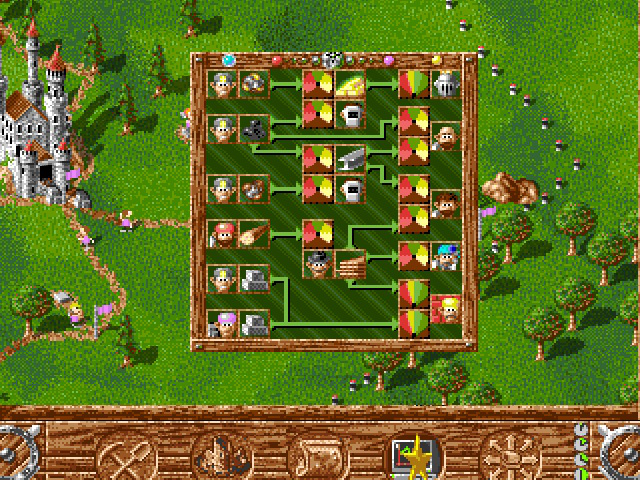
The original Settlers offered the player a charming economic and town-planning simulator with a complex distribution system. Her sequel increased complexity without losing charm.
At the turn of the century, other historical town-planning simulators were also published, including the third game of the Caesar series, which focused even more on simulation aspects, Anno 1602 (1998), the first game in the excellent series of Anno hybrids RTS / urban planning / trade, and a large number of successful games from the developer Caesar Impressions Games.
Caesar IV , the latest game in the Caesar series, appeared only in 2006. Its development was led by former employees of the defunct Impressions Games. It presents a fully three-dimensional graphics, which has become a fashionable replacement for an isometric view of the past.

In Anno 1602, a player builds a colonial city (or cities) and trades to improve their economy.
Complexity
However, SimCity 3000 (1999) overshadowed all of them, greatly adding to the difficulty compared to its predecessor and demanding that the players even manage waste disposal and enter into trade agreements with neighboring cities.
SimCity 4 appeared in 2003, received admiring reviews and numerous awards, however, it was criticized for its over-sophisticated gameplay - the series became so complex that the general public could not appreciate it. The transport system was reworked, a much more detailed simulation of the life of the city was created, regions with several cities and the MySim mode (for integration with The Sims ), a cycle of day and night, and an infinite number of other changes were added.
But the wealth of new features and improvements meant nothing to those who could not even build a working metro network. It seemed that the construction and management games had reached their peak, and SimCity in particular could not risk a further increase in complexity.

For many fans, the SimCity 4 series has gone too far in realism.
Filling in the blanks
The new part of SimCity was not eight years apart from the forgotten SimCity Societies , which was forgotten by the 2007 spin-of, in which six “social values” were added that can change the appearance of the city in the process of its development. While the fans demanded new versions of the epoch-making urban franchise, other games appeared, seeking to fill the gap.
The Tropico series continued with the release in late 2009 of the warmly received Tropico 3 . This version brought the game to polygonal 3D and complemented the political simulation. It even appeared a custom player avatar, traveling around the island, interacting with the environment and solving their problems (or running away from the rebels).

Tropico 3 .
Cities XL 2011 got rid of the MMO component, which was the core of its unsuccessful predecessor ( Cities XL ), which allowed players to trade with each other on a common "planet", and instead focused on the previously underestimated single-player campaign. The main thing was that the Cities XL franchise had a smoother learning curve than SimCity 4 , which made the deep urban simulators available to the new generation (without forcing them to play the previous games of the genre).

Cities XL 2011 had all the hallmarks of a spiritual follower of SimCity .
Fans of simplicity of old town-planning simulators could still draw their hearts, because there appeared portable adaptations of SimCity 3000 for Nintendo DS and iOS devices, open-source projects, for example, LinCity and Micropolis (based on the original SimCity ). More simple games like Virtual City could also become a good acquaintance with the genre.
The long absence of SimCity was a blessing in disguise, because it stimulated new developers to take on the genre and innovate without fear of being crushed by big names and marketing the main pillars of the genre.

Virtual City .
Master of the situation
Many games that simulate a policy or government have done this allegorically, turning them into another element of a larger management simulator, such as in Tropico or integrating them into a strategy game, like in Civilization or Romance of the Three Kingdoms . But some games have focused their gameplay exclusively on political mechanisms. Chief among them was Chris Crawford's important for the industry in the Cold War entourage of Balance of Power (1985), which put the player in the shoes of either the US President or the Secretary General of the Communist Party of the Soviet Union. In this slightly cynical, but nonetheless realistic and complex simulation of the relations between the two superpowers, your goal is to prevent nuclear war - a task much more complicated than it seems.
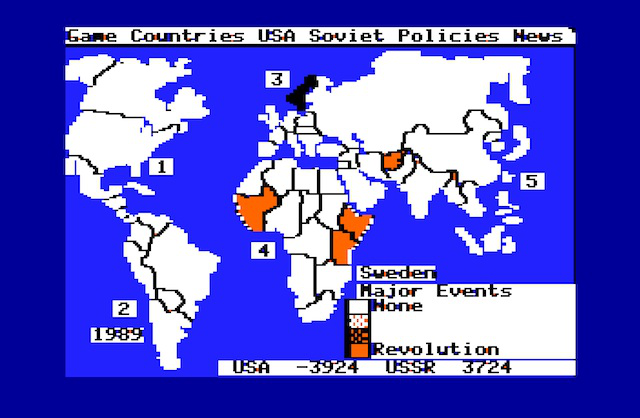
It may seem like a clone of Risk , but the Balance of Power was a deep political simulation.
Closer to our time, Elixir Studios released Republic: The Revolution (2003), in which citizens' political initiative was simulated. The player sought to arrange a coup for the overthrow of the president in the fictional former republic of the Soviet Union. It was followed by the impressive Postiech Games Democracy (2005). Both in Democracy and in its sequel Democracy 2(2007) the player played the role of president or prime minister of one of ten democratic countries. Balancing taxes, public opinion, party policies and lobbyist groups you need to maintain stability in the country and make sure that people are happy enough to re-elect you again. It was a difficult task, almost like running a real country.
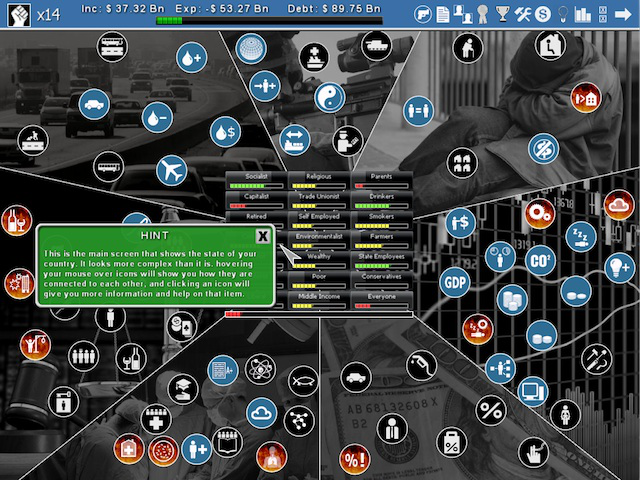
Democracy 2 is not as difficult as it seems, but really close enough to that.
Become more serious
Democracy is a good example of a growing Sims version called " serious games ." In these games, the problems of the real world are raised, they are intentionally made in order to tell the players about their topic or convince them of their point of view. Although government and economy simulators are considered the most serious games, they are not the only ones. Many transport simulators described in this article can be considered serious games. Other examples include America's Army , Simport , Darfur is Dying, and IBM 's CityOne .
But when reality becomes too boring, you can always play the role of God.
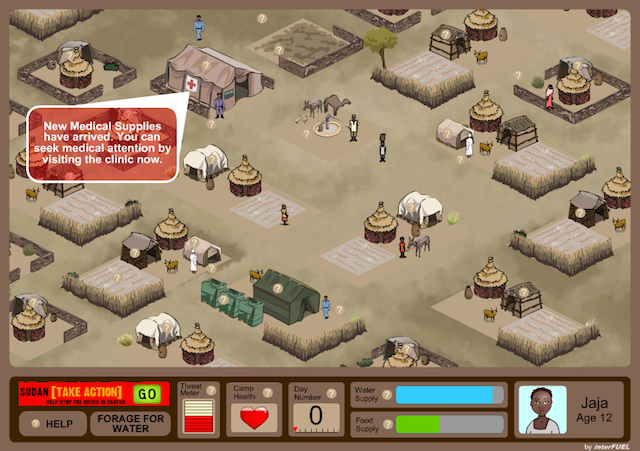
Darfur is Dying of the MtvU TV channel talks about the problem of genocide in Sudan.
If i were god
Peter Molinho is probably better known today for the Fable series and his habit of making ridiculous and sometimes false promises about the possibilities of his future games. But long before Fable, he created a whole genre. In Populous (1989), the second game released by Molinho Bullfrog Productions (after a previous attempt to write office database software), the player became a god and could use the forces of good and evil, as in many subsequent Molinjo games.
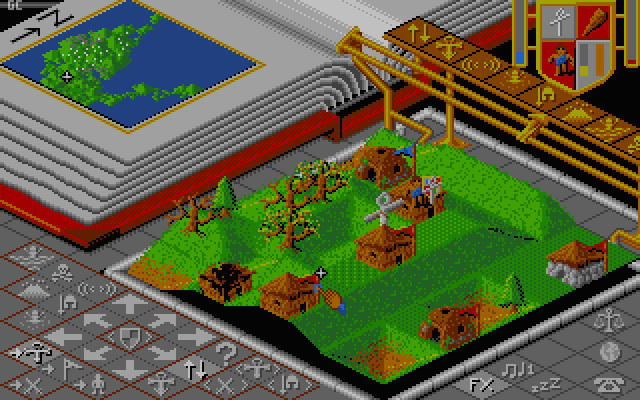
Populous is a god game that invented the god games genre.
Populous and the genre of “God’s simulator” as a whole hadsomething incommon with building simulators like SimCity : indirect control over people living under your leadership, but did it on a completely different level. Games of this genre give the player and some other forces, for example, control over the weather. Their characteristic feature is the microworlds in which the player can help or interfere with the inhabitants, but does not control their lives or society. If you treat your subordinates badly, they will either hate you or stop believing in you, perhaps in favor of another competitor god. Your strength depends entirely on their faith.
Most intriguingly, this was implemented in another game, Molinho. In Black & WhiteIn 2001, players engaged in the cultivation of a huge creature living with the inhabitants of several islands. Being a god, you could be kind or cruel to your beings, or, like me, a little of both, just to see what happens. In turn, the creature developed certain habits and personality traits that influenced its communication with the inhabitants. It could become a fearsome beast, destroying the landscape and everyone around for no reason, or helping and kindhearted, doing everything possible for the safety, saturation and entertainment of people.
Unfortunately, Black & Whiteunable to reach their full potential, the first stages were far superior to the latter, and the AI of the creature turned out to be less complicated than it seemed at first (although it was good enough to educate the eating feces, hurling people and a helpful polite giant).

Black & White 2 managed to cope with many of the shortcomings of its predecessor, and at the same time it sometimes created a rather impressive picture.
Other interesting examples of the development of the God Simulator genre are the RTS / Dungeon Keeper and Afterlife (1996)hybrid. The latter satirically modeled creatures known as “ethically formed biological organisms” who went to hell or heaven (both parodied human society) according to their virtues and sins.

Afterlife was a kind of mixture of SimCity and God simulators.
Little computer people
One can argue about whether God’s simulators are a subset of life simulators — games that simulate humans (or other creatures) and their lives. Such discussions do not relate to the topic of our article, but these two genres of simulators are closely intertwined, mainly because the game that dominates in their market has become another genre in itself. But before moving on to The Sims , let's take a step back.
Before the advent of the “virtual dollhouse” there was a “house on a disk”. Little Computer People (1985) gave the player a (virtual) person who lived in a virtual house stored on a single floppy disk. The player could look into the life of a little computer man, but only offerpossible actions for him (exclusively for a man due to memory limitations). The player could interact with him, entering teams, giving gifts and patting him on the head (from time to time it was even possible to play cards with him). Sometimes he completely ignored the player, sometimes he answered so flowery that the player could get the impression of his rationality.
This unique personality and character was a genius find in the face of huge technical limitations. The computer man did what he wanted, when he wanted, in accordance with his interests, needs and desires. Very often he touched the monitor and asked the player a question. Or wrote him letters on a typewriter standing on the top floor.

Little Computer People - they are not very different from us.
Little Computer People was ahead of its time for many years, and many so attached to the little man in their computer that the developers created a service to transfer the “brain” of the little computer man to a new disk to protect against data damage. But the game did not earn enough money to deserve a sequel, and the idea of a game that simulates someone’s daily life went into shadow until Will Wright and Maxis programmer secretly created a demo that Wright called a “virtual dollhouse.”
Adults play dolls
Wright’s dollhouse was given a go-ahead almost immediately after buying Maxis by EA in 1997, and it finally came out for Windows in February 2000, and the Mac version was released five months later. Active participation in the daily life of virtual suburban residents turned out to be more popular than anyone could have imagined - The Sims quickly overcame the one million sales bar, gradually reaching 16 million copies worldwide (almost three times surpassing the previous owner Myst in sales). "The best-selling PC game of all time").
Despite the fact that the game offered a wide range of choices and ways to interact with Sims and their property — not to mention the architecture and design of their homes — many players simply recreated their lives by comparing how their virtual copies (and relatives) acted in the game and in real life.
Designed by Wright, the design adhered to the principle of an open finale, so many abused it or conducted sims on sims. It was a sadistic pleasure to lock a sim in a room without going out or using the toilet (but with a TV or fridge) or to watch the sim drowning in a pool from which you cannot get out. But many players spent time and more productively, so EA managed to release seven extensions, one frivolous of another, and a huge community of creators formed around the construction and design tools.
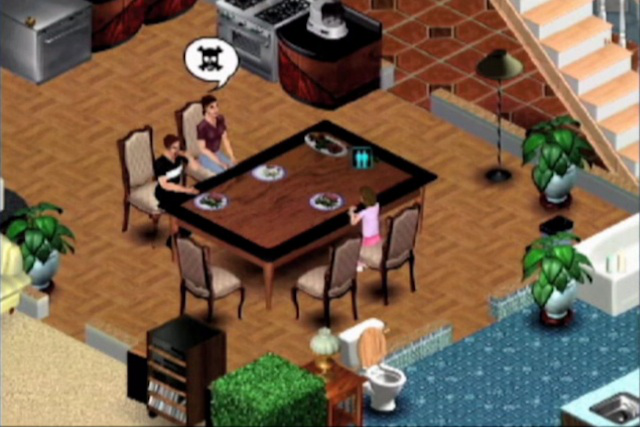
It turns out that some people played The Sims as if it were real life.
The inevitable sequel of The Sims 2 appeared in 2004, but even before it one of the clones hit Space Store shelves - Space Colony (2003).
Space Colony had two important differences from The Sims : it changed the open-ended gameplay to mission structure and fixed initial character set, and also changed the surroundings of the suburbs to the unusual world of a futuristic space colony. Space Colony is comparable to The Sims in humor and general eccentricity, but it could not significantly reduce sales of the large EA franchise.

Space Colony is one of a handful of games that have tried to compete with The Sims .
The Sims 2 , based on the foundation of its predecessor, added to the gameplay the days of the week, additional stages of life, genetic traits (including dominant and recessive genes that influenced the appearance and personality of the descendant of the sim), 3D graphics, significantly improved behavior AI and better mod creation system. The release of the game was followed by eight extensions and nine “sets of items”, and The Sims franchiseleaked into popular culture.
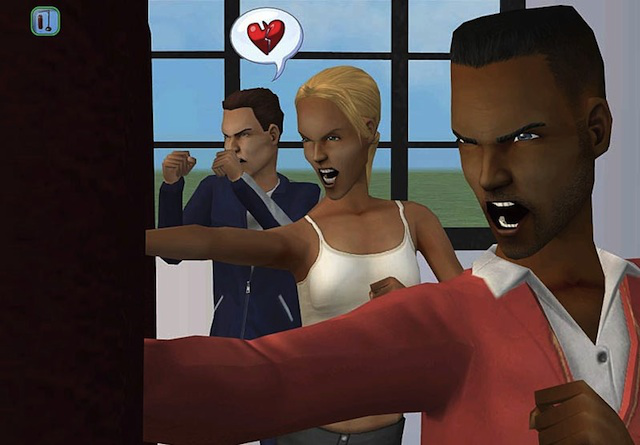
The Sims 2 has become a serious step in graphics and in simulation.
The worthy but shallow spin-off of MySims for consoles and the closing in 2008 of EA Land's MMO-adaptation(originally released under the name The Sims Online ) in June 2009 was followed by The Sims 3 , released simultaneously for Mac and Windows (in 2010 they released ports for consoles).
The sims 3gave players a much greater access to the world of their sims, revealing whole neighborhoods and places of work of sims. Each sim had a clearly defined personality with certain skills, habits and goals that influenced his behavior and growth. And finally, the Sims became smart enough that the player could just watch the game, allowing them to "live" and watch how they pave their own way in the world.
This was particularly effective and acute in the game of Robin Burkinshaw, whose experiment with the homelessness of Sims set a goal to track the life of an eccentric Kev and his daughter Alice, who tried to survive while sleeping on a bench in an abandoned park without money and possessions.

The Sims 3 further expanded the boundaries of AI and graphics, greatly increasing the autonomy of the Sims.
How about a date?
With the exception of a few hybrids, such as Persona and Star Ocean , dating simulators have never been popular outside of Japan. However, in Japan itself, the genre flourished, stretching its tentacles into all kinds of games.
However, the title of “simulator” can be considered wrong, because in most dating simulators there was very little of simulation - mostly they were played as RPG strategies, text adventure games or visual novels. Some had explicit sex content, but many did not. Only very niche games went down to such depravity as the “rape simulator” of Rapelay . But they all tried to simulate romantic relationships between people.
Girl's Garden and Tenshitachi no gogo became noticeable early date dating simulators, and the Tokimeki Memorial series has gained wide popularity since its introduction in the mid-90s. The text game of the 1987 Romantic Encounters at the Dome was probably the first original English-language dating simulator.
The spin-off genre, commonly called the “girlfriend simulator”, has become even stranger, and Real Kanojo (translated as “real girlfriend”) has become popular thanks to 3D real-time and head tracking.

Real Girlfriend - because the imaginary is no longer enough.
Love puppies
Sims also moved from people to animals. An outstanding virtual pet game (I don’t consider Tamagotchi here) Dogz: Your Computer Pet (1995) was created by Night Trap designer Rob Fulp as a reaction to his previous controversial game. Fulop wanted to create something so sweet and charming that no one could call it harmful to children. Therefore, he created a virtual puppy living on a computer screen. Dogz was so popular that it was followed by the Catz kittens version (1996), and then the whole Petz series.
The Petz series, along with other virtual animal games such as Nintendogs (which added touch control), Neopets (1999 and beyond) and Creatures (1996), gradually added a simulation of breeding and genetics, and a strange game for Dreamcast Seaman (1999) experimented with the idea of a virtual pet who can communicate with the player, asking questions about his interests, and sometimes demonstrating impressive intelligence.
The latest innovation in games with virtual pets was motion control: in Kinectimals for the Xbox 360 Kinect and Eyepet for the PlayStation 3.

Catz and Dogz got a huge success thanks to a competent marketing positioning and the presence of a cute animal on the computer screen.
What's next: airplanes, trains, and cars
Simulation of people and their policies have become the main goal of video games simulators for the last two decades, but in the second half of the history of the genre we will turn away from people and carefully consider transport and business simulators. The genre of simulators, from the Il-2 Sturmovik to the RollerCoaster Tycoon , allowed players to take control of an impressive array of airplanes, spaceships and trains, as well as simulate an amazing array of different businesses.
All Articles